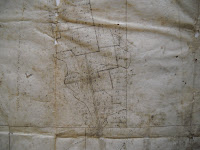 One of the questions we get asked most is "what's the oldest item in the library?" The answer is a cuneiform cone from ca. 1930 B.C. This type of cone was typically embedded in the foundation of a temple and gave the name of the king responsible for erecting the structure and the deity to whom the structure was dedicated. This terra-cotta cone is from the reign of Lipit-Ishtar, King of Isin, and was purchased from Edgar Banks in 1934 by Harold Rugg, the assistant librarian at the time.
One of the questions we get asked most is "what's the oldest item in the library?" The answer is a cuneiform cone from ca. 1930 B.C. This type of cone was typically embedded in the foundation of a temple and gave the name of the king responsible for erecting the structure and the deity to whom the structure was dedicated. This terra-cotta cone is from the reign of Lipit-Ishtar, King of Isin, and was purchased from Edgar Banks in 1934 by Harold Rugg, the assistant librarian at the time.A partial transcription of the cuneiform inscription can be found in one of the letters housed with the cone. The transcription was made by an unnamed Harvard professor and according to the letter reads:
The divine Libit-Ishtar, the humble shpherd of Nippur,
the faithful husbandman of Ur, who does not change the face of
Edridu, a lord who befits Erech, the king of Isin,
the king of Sumer and Akkad, (Col. 2)
who captivated the heart of Inninni, am I.
When justice in Sumer and Akkad he had established,
.....[unknown]....
The temple of justice he built.
Ask for Codex 001558 to see the cone and associated letters.


